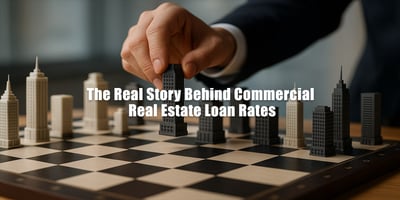Look, I'm going to tell you something that's going to piss off every house-flipping guru on...
Why Visual Planning Is Key to Commercial Real Estate Showings
In the high-stakes world of commercial real estate, a single property showing can make or break a multi-million dollar deal. Yet, most agents approach these critical moments with little more than a set of keys and a hope that the space will "speak for itself."
It doesn't.

The Hidden Cost of Unprepared Presentations
Picture this scenario: You're standing in a 15,000 square foot warehouse with a potential client who's considering it for their expanding e-commerce operation. The space is perfect for their needs, but as you walk through, you find yourself pointing vaguely at corners, stumbling over explanations of traffic flow, and struggling to help them visualize how their operation would actually function in the space.
The client leaves with more questions than answers. Three weeks later, they sign with a competitor who showed them a smaller, more expensive space but one where they could clearly see their business thriving.
This happens more often than any of us would like to admit. The difference between a successful showing and a missed opportunity often comes down to one crucial factor: preparation.
Beyond the Virtual Tour: The Psychology of Physical Space
While virtual tours and high-quality photography have revolutionized how we market commercial properties, they can't replace the power of a well-orchestrated in-person showing. There's something irreplaceable about standing in a space, feeling its energy, and imagining possibilities.
However, this physical experience only works when it's guided properly. Clients don't automatically see potential, they need to be shown it. They need to understand not just what the space is, but what it could become for their specific business needs.
This is where most commercial real estate professionals fall short. They rely on spontaneous inspiration rather than strategic presentation.
The Theater of Commercial Real Estate
The most successful commercial real estate agents understand something that their competitors miss: a property showing is essentially a performance. Like any good performance, it requires a script, staging, and careful attention to pacing and flow.
Consider how film directors approach storytelling. They don't simply point a camera at actors and hope for the best. Every shot is planned, every angle considered, every moment crafted to guide the audience's emotional journey. The same principles apply to property showings.
When you walk a client through a space, you're telling a story, the story of how their business will thrive in this environment. That story needs structure, visual cues, and strategic reveals that build excitement and confidence.
The Science of Spatial Visualization
Research in environmental psychology shows that people have varying abilities to visualize spatial relationships and imagine how spaces might be used. Some clients can look at an empty warehouse and immediately see their operations humming with activity. Others need much more guidance to make that mental leap.
The agents who consistently close deals are those who can bridge this visualization gap for every type of client. They understand that showing a space isn't just about highlighting features, it's about creating a shared vision of success.
This is particularly crucial in commercial real estate, where the stakes are higher and the decision-making process typically involves multiple stakeholders. If you can't help the facilities manager visualize efficient workflow, or show the CEO how the space enhances their company culture, you're leaving money on the table.
Planning Your Presentation Like a Professional
The solution isn't to rely on natural charisma or hope for the best. The solution is systematic preparation that addresses every aspect of the client experience.
Start with the client's perspective. Before you even schedule the showing, understand their business model, operational requirements, and growth plans. What are their pain points with their current space? What does success look like for them?
Map the journey. Just as a movie has acts and scenes, your property showing should have a logical progression. Where will you start? What will you show first, second, third? How will you build momentum throughout the experience?
Identify key moments. Every property has features that could be game-changers for the right client. A loading dock with perfect truck access. Natural light that floods the workspace. Flexible spaces that can adapt as a business grows. These moments deserve special attention and shouldn't be left to chance.
Anticipate objections. Experienced agents know that certain concerns come up repeatedly. The rent is too high. The space is too small. The location isn't ideal. Rather than addressing these reactively, plan proactive responses that reframe these perceived negatives.
Prepare for different scenarios. What if the client brings unexpected stakeholders? What if they want to focus on aspects of the property you hadn't emphasized? Having a flexible but comprehensive plan allows you to adapt while maintaining control of the narrative.
Visual Planning: The Game-Changer
This is where visual planning tools become invaluable. Traditional property marketing focuses on static images and floor plans, but the showing experience is dynamic and three-dimensional. You need to think cinematically about how the space will be revealed and experienced.
Visual storyboarding allows you to plan your presentation like a director planning a film. You can map out the optimal walking route, identify the best angles for highlighting key features, and create a visual script that ensures nothing important gets overlooked.
For example, instead of randomly walking through a multi-floor office building, you might storyboard an approach that:
- Starts with an impressive lobby shot that sets a professional tone
- Moves to window views that showcase location benefits
- Highlights flexible workspace areas that demonstrate adaptability
- Concludes with executive areas that convey prestige and success
Each "scene" in your storyboard serves a specific purpose in building the client's confidence and excitement about the space.
Technology as Your Creative Partner
Modern visual planning tools have made this level of preparation accessible to every agent, not just those with large marketing budgets or design backgrounds. Platforms like story-boards.ai allow you to quickly create professional-quality visual plans that map out every aspect of your presentation.
You can experiment with different approaches, refine your messaging, and ensure that every showing is optimized for maximum impact. The time invested in planning pays dividends in closing rates and client satisfaction.
The Competitive Advantage

In an industry where the difference between success and failure often comes down to small margins, this level of preparation creates a significant competitive advantage. Clients recognize professionalism when they see it, and they're more likely to trust agents who demonstrate thorough preparation and strategic thinking.
Moreover, well-planned presentations reduce the likelihood of follow-up questions and second showings. When clients can clearly visualize their success in a space, they're ready to move forward with confidence.
Implementation: Making Planning Part of Your Process
The key to success with visual planning is making it a standard part of your workflow, not an occasional enhancement for special properties. Every property deserves thoughtful presentation, and every client deserves your best effort.
Start by analyzing your recent showings. Which ones went exceptionally well, and which ones left you wishing you'd been better prepared? Look for patterns in what works and what doesn't, then develop templates and frameworks that you can adapt for different property types and client needs.
Consider creating visual plans for your most important listings, experimenting with different approaches and measuring results. Track which presentations lead to signed leases and which ones result in clients walking away.
The Future of Property Presentation
As commercial real estate becomes increasingly competitive, the agents who thrive will be those who understand that selling space is really about selling vision. The physical attributes of a property - square footage, location, amenities are just the foundation. The real value lies in helping clients see how those attributes translate into business success.
Visual planning tools are not just a nice-to-have enhancement for tech-savvy agents. They're becoming essential tools for anyone serious about maximizing their effectiveness and providing exceptional client service.
The commercial real estate landscape is evolving rapidly, with clients becoming more sophisticated and expectations rising accordingly. The agents who embrace systematic planning and visual storytelling will find themselves with a decisive advantage in this competitive market.
Your next property showing is an opportunity to demonstrate not just a great space, but your commitment to your client's success. Make it count.
Ready to transform your property presentations? Start planning your showings like a professional with visual storyboarding tools at story-boards.ai.




